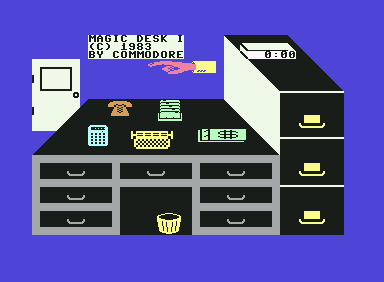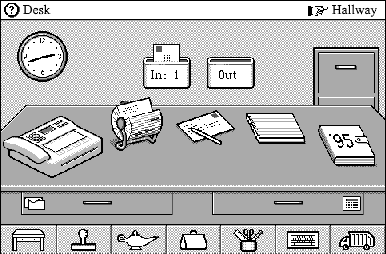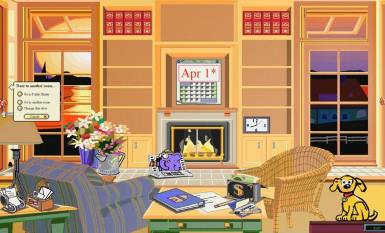3D office: a false idea
Creating an interface with files as a 3D desktop has always been unsuccessful.
Even Microsoft tried, and almost no one knows, because the project was abandoned immediately after the release. The concept of presenting a computer interface in the form of a real desktop still looks interesting, but in practice it is completely unsuitable.
The Magic Cabinet

The Magic Table was invented back in 1983 for the Commodore 64 computer. By that time, computers were controlled on the command line, McIntosh was not released, its interface already existed in Lisa, but the latter was sold in very small copies.
Therefore, the idea of a graphical interface for accessing content in a figurative form was very innovative .
In the image on the right, you can see the keyboard, calculator, trash can and other objects, but most of them do not correspond to any real commands.
When you click on the machine, a sheet of paper appears or the typed lines are added, and you can place it in a folder. By clicking on the clock, you get the time and date. You can also put the document in the recycle bin.
This magic cabinet was supplied in a cartridge and was not very successful. He brought nothing but a text editor! The McIntosh style GUI, GEOS, was proposed for this computer in 1985 instead of the magic desktop.
Magic Cape

Two years after Magic Desk, the idea of a 3D office system was picked up by Bill Atkinson and Andy Herzfeld, former Apple programmers involved in the McIntosh project.
This time it is an operating system for a personal assistant. Regular applications, phone, address book, clock, etc. No images are displayed on the desktop.
By clicking on the Hall (corridor) in the upper right corner, you see a list of rooms that includes the office where you come from, the "room" of parameters, storage, etc.
The success of the Magic Cap depended on which device it was sold with. But the time for personal assistants with a large screen has not yet come, it will come much later, in 2008 with smartphones. No virtual desktop.
Bob from Microsoft

Just before Windows 95, in March 1995, Microsoft released Bob, a file system interface in the form of a room on each object presents an application. His design comes from the research of two Harvard professors, but the idea is quite similar to that of the Magic Desk and Magic Cap.
Microsoft Word is represented by a sheet of paper and a pencil.
To help the user, the comic character talks to the filacters.
Magazines harshly criticized Bob long after his disappearance, which happened very quickly, even before the release of Windows 95 in August .
Bob was made in vector graphics, without any shading or degradation, hence his 70s Apple II look. As with the Magic Desk, most of the items presented are just scenery, which confuses the user. This and its high price are quickly doomed to oblivion.
Conclusion
There is very little chance that this kind of interface will collide with its appearance again. While icons in skeuomorphism (real objects appear) have disappeared on all systems, replaced by abstract images, it is not expected that the cleaned interface of smartphones and applications will be replaced by a figurative image of the system.
The 3D office is apparently not the most convenient, but this is what matters to the user.
See also:
Graphical user interface.